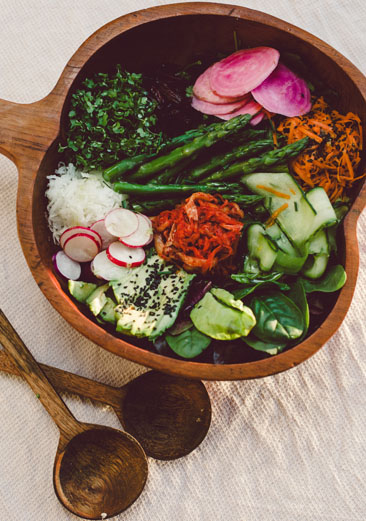Buddah Bowls
/For many years, UK Government guidelines have suggested eating 5 portions of fruit and vegetables a day, but it is now suggested that this advice should be doubled to 10 portions per day. The recommendation for 10-a-day is from a study that found high consumption of vegetables had a protective effect against risk of premature death. In clinic we emphasise eating a variety of plant foods every day in order to help maintain a healthy gut, as it only takes a few days of a low fibre diet for the microbe population in the gut to change. To increase your intake of vegetables it may be easier to move away from the emphasis on portion sizes and focus instead on increasing variety. The Japanese are taught from childhood to eat 30 different foodstuffs a day, and their culture of eating many small, often plant based, dishes each mealtime makes this more easily achievable. A Buddah Bowl mirrors this variety of dishes, but all in one large, rainbow-coloured bowl of prebiotic vegetables and wholegrains, along with a probiotic serving. It is a flexible dish meaning you can add whatever you have on hand. Make it easy and convenient by keeping a fridge well-stocked with fermented vegetables and doubling up on cooking portions of grains or roasted vegetables at meal times. In the summer, add raw seasonal vegetables and in the winter months roast, lightly steam or sauté vegetables and add warming spices. The Buddah Bowl Choose deep bowls, and add: Vegetables Choose 2 or 3 or more of the following: Spring Onion Leek Jerusalem artichokes Asparagus (in the summer shave them raw into the bowl) Cooked and cooled new potatoes Sweet potatoes sautéed in coconut oil with turmeric Radishes Avocado Shiitake mushrooms fried in oil and garlic Lightly steam a couple of handfuls of leafy greens tossed in olive oil, hemp oil or avocado oil Green beans Brussel sprouts fried in butter Broccoli Cauliflower florets Grated carrots Roasted or grated raw beetroot Sliced fennel Cucumber Tomatoes Roasted seasonal vegetables, e.g. butternut squash, carrots or aubergine Chopped fresh herbs Cooked wholegrains and legumes, such as Pearl Barley Chickpeas Cous cous Quinoa Red Camargue rice White beans Lentils Buckwheat noodles Seasonings Warming spices, e.g. turmeric, garlic, cumin Black and white sesame seeds Dukkah or roasted chopped nuts Shichimi togarashi Finally add a probiotic serving Kimchi Sauerkraut Fermented greens, radishes, carrots or beetroot Kefir vinaigrette Tahini and greek yoghurt sauce Kefir cheese



